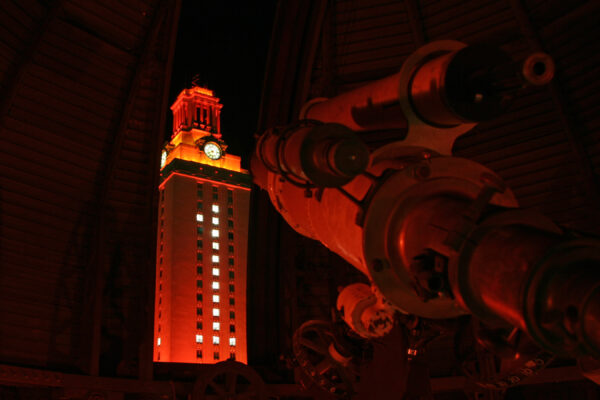No time to make the drive from Austin to the McDonald Observatory in Fort Davis? Good thing telescopes on campus can bring the stars to you.
The University of Texas at Austin has telescopes on the roofs of Robert Lee Moore Hall and Painter Hall, and they are available for public viewing three nights a week at select times.
Lara Eakins, the education, outreach and visitor program coordinator for the Astronomy Department, says the goal is to provide an opportunity to those who might not be able to afford their own telescope or don’t know how to use one, with an astronomy staff member or student on hand to answer questions.
“It’s a great way for us to let them still enjoy astronomy without necessarily having to do a whole bunch of stuff on their own,” Eakins says. “It’s also part of our education here because we do serve some of the students in astronomy classes as well.”
The telescope on the roof of RLM is a reflecting telescope; the Painter telescope is an antique refraction model that must be manipulated by hand, constructed in the 1930s with a lens that is now more than 100 years old. Eakins says neither is better than the other because they do different things. The RLM telescope can be used to show precise coordinates in the night sky, while the refracting telescope can see objects closer to the horizon, such as Mercury, because of its lower vantage point.
Eakins says that because of light pollution, the only objects that can be seen are either especially close or bright.
“We are somewhat limited to primarily the planets of our solar system, although we can’t see Mercury, at least on RLM,” Eakins says. “We’ll go fainter and show planets like Uranus and Neptune, which are further out, so they are a lot fainter this summer. The really big bright objects are Saturn and Jupiter, which are both really fun to see through a telescope because you can see the rings of Saturn.”
The RLM telescope is available Wednesdays and the Painter on Fridays and most Saturdays when the university is in session. Public viewing hours change and can be found on the program website, along with more information about the telescopes and public viewing nights. To check for possible weather cancellations, call 512-232-4265.



